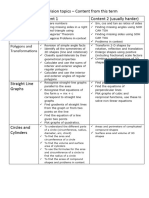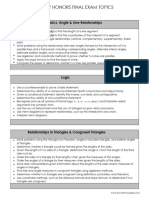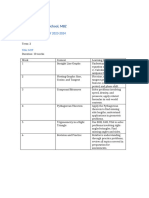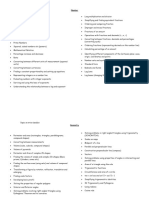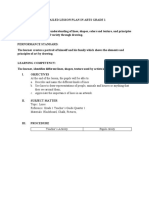0 ratings0% found this document useful (0 votes)
24 views5 Mathematics Measurement & Geometry Levels 7-10A
5 Mathematics Measurement & Geometry Levels 7-10A
Uploaded by
Damon KeyThis document outlines mathematics achievement standards related to measurement and geometry at different levels from 7 to 10A. Key areas covered include:
- Calculating areas and volumes of shapes like rectangles, triangles, cylinders, prisms and composite solids.
- Using formulas to solve perimeter and area problems for shapes like parallelograms and circles.
- Describing transformations like translations, reflections and rotations on a coordinate plane.
- Establishing properties of shapes like parallel lines, angles and triangles.
- Applying concepts like Pythagoras' theorem, trigonometry, and similarity to solve problems involving triangles.
Copyright:
© All Rights Reserved
Available Formats
Download as PDF, TXT or read online from Scribd
5 Mathematics Measurement & Geometry Levels 7-10A
5 Mathematics Measurement & Geometry Levels 7-10A
Uploaded by
Damon Key0 ratings0% found this document useful (0 votes)
24 views1 pageThis document outlines mathematics achievement standards related to measurement and geometry at different levels from 7 to 10A. Key areas covered include:
- Calculating areas and volumes of shapes like rectangles, triangles, cylinders, prisms and composite solids.
- Using formulas to solve perimeter and area problems for shapes like parallelograms and circles.
- Describing transformations like translations, reflections and rotations on a coordinate plane.
- Establishing properties of shapes like parallel lines, angles and triangles.
- Applying concepts like Pythagoras' theorem, trigonometry, and similarity to solve problems involving triangles.
Copyright
© © All Rights Reserved
Available Formats
PDF, TXT or read online from Scribd
Share this document
Did you find this document useful?
Is this content inappropriate?
This document outlines mathematics achievement standards related to measurement and geometry at different levels from 7 to 10A. Key areas covered include:
- Calculating areas and volumes of shapes like rectangles, triangles, cylinders, prisms and composite solids.
- Using formulas to solve perimeter and area problems for shapes like parallelograms and circles.
- Describing transformations like translations, reflections and rotations on a coordinate plane.
- Establishing properties of shapes like parallel lines, angles and triangles.
- Applying concepts like Pythagoras' theorem, trigonometry, and similarity to solve problems involving triangles.
Copyright:
© All Rights Reserved
Available Formats
Download as PDF, TXT or read online from Scribd
Download as pdf or txt
0 ratings0% found this document useful (0 votes)
24 views1 page5 Mathematics Measurement & Geometry Levels 7-10A
5 Mathematics Measurement & Geometry Levels 7-10A
Uploaded by
Damon KeyThis document outlines mathematics achievement standards related to measurement and geometry at different levels from 7 to 10A. Key areas covered include:
- Calculating areas and volumes of shapes like rectangles, triangles, cylinders, prisms and composite solids.
- Using formulas to solve perimeter and area problems for shapes like parallelograms and circles.
- Describing transformations like translations, reflections and rotations on a coordinate plane.
- Establishing properties of shapes like parallel lines, angles and triangles.
- Applying concepts like Pythagoras' theorem, trigonometry, and similarity to solve problems involving triangles.
Copyright:
© All Rights Reserved
Available Formats
Download as PDF, TXT or read online from Scribd
Download as pdf or txt
You are on page 1of 1
Mathematics – Measurement and Geometry: Level 7 – Level 10A
Level 7 Level 8 Level 9 Level 10 Level 10A
Measurement and Geometry
Using units of measurement
Establish the formulas for areas of rectangles, triangles and Choose appropriate units of measurement for area and volume Solve problems involving surface area and volume for a range of Solve problems involving surface area and volume of right
Calculate the areas of composite shapes
parallelograms and use these in problem solving and convert from one unit to another prisms, cylinders and composite solids pyramids, right cones, spheres and related composite solids
Find perimeters and areas of parallelograms, trapeziums, Calculate the surface area and volume of cylinders and solve
Calculate volumes of rectangular prisms
rhombuses and kites related problems
Investigate the relationship between features of circles such as
circumference, area, radius and diameter. Use formulas to solve Solve problems involving the surface area and volume of right
problems involving determining radius, diameter, circumference prisms
and area from each other
Develop the formulas for volumes of rectangular and triangular
prisms and prisms in general. Use formulas to solve problems Investigate very small and very large time scales and intervals
involving volume
Solve problems involving duration, including using 12- and 24-
hour time within a single time zone
Shape
Draw different views of prisms and solids formed from
combinations of prisms
Location and transformation
Describe translations, reflections in an axis, and rotations of
multiples of 90° on the Cartesian plane using coordinates.
Identify line and rotational symmetries
Geometric reasoning
Define congruence of plane shapes using transformations and
Identify corresponding, alternate and co-interior angles when two use transformations of congruent shapes to produce regular Use the enlargement transformation to explain similarity and Formulate proofs involving congruent triangles and angle
Prove and apply angle and chord properties of circles
straight lines are crossed by a transversal patterns in the plane including tessellations with and without the develop the conditions for triangles to be similar properties
use of digital technology
Apply logical reasoning, including the use of congruence and
Investigate conditions for two lines to be parallel and solve simple
Develop the conditions for congruence of triangles Solve problems using ratio and scale factors in similar figures similarity, to proofs and numerical exercises involving plane
numerical problems using reasoning
shapes
Establish properties of quadrilaterals using congruent triangles
Demonstrate that the angle sum of a triangle is 180° and use this
and angle properties, and solve related numerical problems using
to find the angle sum of a quadrilateral
reasoning
Classify triangles according to their side and angle properties and
describe quadrilaterals
Pythagoras and trigonometry
Investigate Pythagoras’ Theorem and its application to solving Solve right-angled triangle problems including those involving Establish the sine, cosine and area rules for any triangle and
simple problems involving right angled triangles direction and angles of elevation and depression solve related problems
Use the unit circle to define trigonometric functions as functions
Use similarity to investigate the constancy of the sine, cosine and
of a real variable, and graph them with and without the use of
tangent ratios for a given angle in right-angled triangles
digital technologies
Apply trigonometry to solve right-angled triangle problems Solve simple trigonometric equations
Apply Pythagoras’ theorem and trigonometry to solving three-
dimensional problems in right-angled triangles
Achievement Standard
Students use formulas for the area and perimeter of rectangles. Students convert between units of measurement for area and for Students solve measurement problems involving perimeter and Students solve and explain surface area and volume problems
They classify triangles and quadrilaterals and represent volume. They find the perimeter and area of parallelograms, area of composite shapes, surface area and volume of relating to composite solids. They use parallel and perpendicular
transformations of these shapes on the Cartesian plane, with and rhombuses and kites. Students name the features of circles, rectangular prisms and cylinders, with and without the use of lines, angle and triangle properties, similarity, trigonometry and
without the use of digital technology. Students name the types of calculate circumference and area, and solve problems relating to digital technology. They relate three-dimensional objects to two- congruence to solve practical problems and develop proofs
angles formed by transversals crossing parallel lines and solve the volume of prisms. They make sense of time duration in real dimensional representations. Students explain similarity of involving lengths, angles and areas in plane shapes. They use
simple numerical problems involving these lines and angles. applications, including the use of 24-hour time. Students identify triangles, interpret ratios and scale factors in similar figures, and digital technology to construct and manipulate geometric shapes
They describe different views of three-dimensional objects, and conditions for the congruence of triangles and deduce the apply Pythagoras's theorem and trigonometry to solve problems and objects, and explore symmetry and pattern in two dimensions.
use models, sketches and digital technology to represent these properties of quadrilaterals. They use tools, including digital involving angles and lengths in right-angled triangles.
views. Students calculate volumes of rectangular prisms. technology, to construct congruent shapes.
© VCAA 24 February 2016
You might also like
- BDA (Before, During After) Lesson Plan TemplateDocument3 pagesBDA (Before, During After) Lesson Plan Templateapi-404225281No ratings yet
- Grigori Grabovoi: Concentration EXERCISE - 31 Days Alligned To The According Day of The MonthDocument10 pagesGrigori Grabovoi: Concentration EXERCISE - 31 Days Alligned To The According Day of The MonthHakan GurbuzNo ratings yet
- 10 Maths Term 4 Unit Plan 2021Document3 pages10 Maths Term 4 Unit Plan 2021Jeremy JaquesNo ratings yet
- 10 Maths Term 4 Unit PlanDocument3 pages10 Maths Term 4 Unit PlanJeremy JaquesNo ratings yet
- Geometry & Measurement Unit 4: Perimeter and Area of Plane Figures Unit 4: Similarity of FiguresDocument2 pagesGeometry & Measurement Unit 4: Perimeter and Area of Plane Figures Unit 4: Similarity of FiguresyitagesNo ratings yet
- Geometry TopicsDocument4 pagesGeometry TopicsRejieNo ratings yet
- Geometry StandardsDocument19 pagesGeometry Standardsapi-487859818No ratings yet
- CDS SyllabusDocument4 pagesCDS SyllabusManish AgrawalNo ratings yet
- Year 8 EOY Revision Topics - Includes All Previous ListsDocument4 pagesYear 8 EOY Revision Topics - Includes All Previous Listslyang1No ratings yet
- Final TopicsDocument3 pagesFinal TopicsvanikajivanNo ratings yet
- Unpacking DiagramDocument1 pageUnpacking DiagramJohn Lewis SuguitanNo ratings yet
- Math Final Geometry Standards 4 - 2 - 2018Document9 pagesMath Final Geometry Standards 4 - 2 - 2018Luke ThorneNo ratings yet
- 08_bc_precal12_te_ch08 (1)Document100 pages08_bc_precal12_te_ch08 (1)b924czcsdfNo ratings yet
- MathsDocument7 pagesMathsVaishnav VIPANCHIKANo ratings yet
- ME1 Course OutlineDocument3 pagesME1 Course OutlineBenjamin FerilNo ratings yet
- Geometry Performance IndicatorsDocument10 pagesGeometry Performance IndicatorsSravan Kumar ChallojuNo ratings yet
- ICSE Class 9 Maths Syllabus Sl. No. Chapter Name SubtopicsDocument2 pagesICSE Class 9 Maths Syllabus Sl. No. Chapter Name SubtopicsSanjay SahooNo ratings yet
- Maths Igcse Scheme of Work 0580 - 2011Document6 pagesMaths Igcse Scheme of Work 0580 - 2011Yenny Tiga0% (1)
- Mathematics D Syllabus BreakdownDocument3 pagesMathematics D Syllabus BreakdownMuhammad Samhan100% (1)
- Higher Revision ChecklistDocument1 pageHigher Revision ChecklistJones JonnyNo ratings yet
- Webinar_053018_Handout_High_Impact_IndicatorsDocument3 pagesWebinar_053018_Handout_High_Impact_Indicatorsemoorer.studentNo ratings yet
- Maths IGCSE Scheme of Work 0580 - 2011Document6 pagesMaths IGCSE Scheme of Work 0580 - 2011Yenny TigaNo ratings yet
- Revised_Midterm_Plan_T2_Y10Document1 pageRevised_Midterm_Plan_T2_Y10milou milouNo ratings yet
- MFM 2P0 Evidence RecordDocument6 pagesMFM 2P0 Evidence Recordpurple71No ratings yet
- Dragon Box Elements PDFDocument2 pagesDragon Box Elements PDFanon_366832989No ratings yet
- PLD GeometryDocument11 pagesPLD Geometryapi-310256368No ratings yet
- RCJ - Educ 216A Assessment of Learning Competencies and ObjectivesDocument3 pagesRCJ - Educ 216A Assessment of Learning Competencies and Objectiveslmrana00004No ratings yet
- MYP MathDocument7 pagesMYP MathThe Nextwave-DepatsNo ratings yet
- Updated Mathematics Syllabus For Regional and National Level MSM 2024Document3 pagesUpdated Mathematics Syllabus For Regional and National Level MSM 2024Allied Schools Pirmahal CampusNo ratings yet
- Trigonometry Unit Plan: Title of Unit Grade Level Subject Time Frame Developed byDocument11 pagesTrigonometry Unit Plan: Title of Unit Grade Level Subject Time Frame Developed byapi-547915807No ratings yet
- Mathematics ActivityDocument5 pagesMathematics ActivityJudylyn AbalosNo ratings yet
- GR 8-NumberDocument96 pagesGR 8-NumberZabrinaNo ratings yet
- Year 9 Proficiency Level DescriptorsDocument2 pagesYear 9 Proficiency Level DescriptorsJohnnyLuanKhaiTuanNo ratings yet
- 3rd Periodical Test in MATH 4Document9 pages3rd Periodical Test in MATH 4Maria Adelyn MatibagNo ratings yet
- Topics List 2023Document1 pageTopics List 2023smithson319No ratings yet
- SUBJECT: Mathematics: PT 1 (8.7.19 To 12.07.19)Document2 pagesSUBJECT: Mathematics: PT 1 (8.7.19 To 12.07.19)Arnav Raju GhoteNo ratings yet
- A. Geometry of Shape and Size: Geometry (3Rd Year High School)Document4 pagesA. Geometry of Shape and Size: Geometry (3Rd Year High School)Raymond Gorda100% (1)
- Maths 3rd RAG 2023 (2)Document2 pagesMaths 3rd RAG 2023 (2)miaherbs4No ratings yet
- Gr.8-Shape and SpaceDocument42 pagesGr.8-Shape and SpaceZabrinaNo ratings yet
- Geometry BookDocument249 pagesGeometry BookMarizza Bailey100% (1)
- Stage 1-Desired Results: Established GoalsDocument35 pagesStage 1-Desired Results: Established GoalsMark Anthony EspañolaNo ratings yet
- End of Myp Exam ChecklistDocument4 pagesEnd of Myp Exam ChecklistAsja AvdićNo ratings yet
- Grade 5 Mathematics MeshDocument25 pagesGrade 5 Mathematics MeshScribdTranslationsNo ratings yet
- Geometry Scaffolding FrameworkDocument10 pagesGeometry Scaffolding FrameworkMelanieNo ratings yet
- Explaining Area and Circumference of A Circle: Earning AP NformationDocument39 pagesExplaining Area and Circumference of A Circle: Earning AP NformationDimas HakriNo ratings yet
- Math 8 DLL 4th Quarter Week 2 LC 49Document6 pagesMath 8 DLL 4th Quarter Week 2 LC 49Cesar Abajo Lingolingo Jr.No ratings yet
- DLL For LC 43.2a - B-Solving Right Triangle (Joya)Document14 pagesDLL For LC 43.2a - B-Solving Right Triangle (Joya)rohanisa.tontoNo ratings yet
- Year 11 Maths PLC Year 10 and 11Document7 pagesYear 11 Maths PLC Year 10 and 11Rav ChumberNo ratings yet
- Geometry CH 8Document70 pagesGeometry CH 8Hajoo LeeNo ratings yet
- Amt Math9quarter3Document19 pagesAmt Math9quarter3Sarah Grace KakaNo ratings yet
- Year 8 Lower Secondary Long Term Plan MathsDocument4 pagesYear 8 Lower Secondary Long Term Plan MathsMahamed AbusnenaNo ratings yet
- UnknownDocument5 pagesUnknownDimple SoniNo ratings yet
- PreCalculus CCSS Curriculum Map Unit 3 Draft - 6 - 12 - 14revDocument8 pagesPreCalculus CCSS Curriculum Map Unit 3 Draft - 6 - 12 - 14revraymart zalunNo ratings yet
- Year 9 Mathematics 2022 - 2023 Unit 2-1Document6 pagesYear 9 Mathematics 2022 - 2023 Unit 2-1Chandrasegran NargesNo ratings yet
- Grade 9 Term 4 Paper 2 Examination Framework 2024 FinalDocument5 pagesGrade 9 Term 4 Paper 2 Examination Framework 2024 FinalthatonezubbieNo ratings yet
- Expanded Unit OverviewDocument3 pagesExpanded Unit Overviewapi-300394682No ratings yet
- BTP I Partial Workday. MathDocument24 pagesBTP I Partial Workday. MathScribdTranslationsNo ratings yet
- 10th Trigonometry Lesson PlanDocument9 pages10th Trigonometry Lesson Plankbalu007No ratings yet
- Edmentun - GeometryDocument5 pagesEdmentun - GeometryLeandro SafraNo ratings yet
- DLL LC49 Fourth - Day1-4Document6 pagesDLL LC49 Fourth - Day1-4juneann.cariagaNo ratings yet
- MathsTraks: Geometry: A Collection of Blackline Masters for ages 11-14From EverandMathsTraks: Geometry: A Collection of Blackline Masters for ages 11-14No ratings yet
- Chapter 6 B GrooverDocument14 pagesChapter 6 B GrooverRizwanNadeemNo ratings yet
- Visualising Solid ShapesDocument24 pagesVisualising Solid Shapespk10117240% (10)
- GE4 LectureDocument9 pagesGE4 LectureMarga NiveaNo ratings yet
- Class 8 - Question Bank Term2 MATHSDocument24 pagesClass 8 - Question Bank Term2 MATHSPari RathodNo ratings yet
- LP in PHEDocument8 pagesLP in PHEApril NovesterasNo ratings yet
- Neurographic Art Nasco EducationDocument4 pagesNeurographic Art Nasco EducationKyla Agustin100% (11)
- 3 Similar TrianglesDocument17 pages3 Similar TrianglesMARY ZIANNE GABRIELLE QUINTONo ratings yet
- Tedu 522 Activity DiaryDocument8 pagesTedu 522 Activity Diaryapi-283147275No ratings yet
- Mathematics Around UsDocument4 pagesMathematics Around Usgyrobox0No ratings yet
- 2D Shapes Lesson PlanDocument2 pages2D Shapes Lesson PlanAnne Erica TrinidadNo ratings yet
- Grade 7 ''Set Operations Involving Line and Its Subsets''Document5 pagesGrade 7 ''Set Operations Involving Line and Its Subsets''Niño Lemuel Lazatin ConcinaNo ratings yet
- Visual Design Is About Creating and Making The General Aesthetics of A Product ConsistentDocument10 pagesVisual Design Is About Creating and Making The General Aesthetics of A Product Consistentsha catsNo ratings yet
- Math Grade 6 Quarter 3Document9 pagesMath Grade 6 Quarter 3Chesca AdolfoNo ratings yet
- Grade 3 GeometryDocument4 pagesGrade 3 Geometrypham doanNo ratings yet
- Transformation Project - 50 Points: OverviewDocument4 pagesTransformation Project - 50 Points: OverviewSymbat OrazalyNo ratings yet
- Ch5a Boundary DescriptorsDocument30 pagesCh5a Boundary DescriptorsMustafa ElmalkyNo ratings yet
- FORM Theory of ArchDocument18 pagesFORM Theory of ArchAbuzaid MohamedNo ratings yet
- Detailed Lesson Plan in Arts Grade 1 and Grade 2Document13 pagesDetailed Lesson Plan in Arts Grade 1 and Grade 2Rica Julea Dacara100% (1)
- Contemporary Arts DLP - PELAEZDocument12 pagesContemporary Arts DLP - PELAEZRegh PelaezNo ratings yet
- Contemporary Philippine Arts From The Regions: The Elements of ArtDocument5 pagesContemporary Philippine Arts From The Regions: The Elements of Artfatimah hanaeiNo ratings yet
- Lesson 4 - Polygons and QuadrilateralsDocument4 pagesLesson 4 - Polygons and Quadrilateralsapi-539087810No ratings yet
- 3rd Grade Math StandardsDocument12 pages3rd Grade Math Standardsdestiny_eastepNo ratings yet
- Y8 Mathematic CambridgeDocument4 pagesY8 Mathematic CambridgehudaNo ratings yet
- Summative Transformations ArtDocument4 pagesSummative Transformations Artapi-242788541100% (1)
- Cie 4 Maths AcpDocument10 pagesCie 4 Maths AcpAKILA PNo ratings yet
- Natural OrderDocument5 pagesNatural OrderMicah Santon100% (2)
- Grade 9 Mathematics SyllabusDocument64 pagesGrade 9 Mathematics SyllabusmshaymutakayaNo ratings yet
- Week-9-15 CM MDL 4Q Mil122Document35 pagesWeek-9-15 CM MDL 4Q Mil122Carmelo Justin Bagunu AllauiganNo ratings yet








